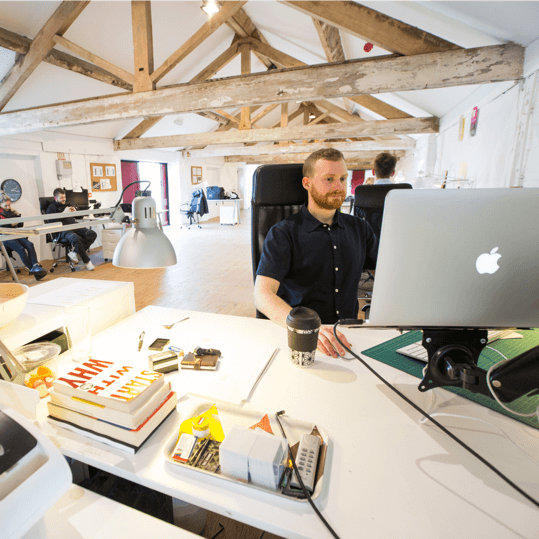In the digital world, user experience (UX) is everything. A visually engaging and intuitive design can make the difference between a user staying on your site or leaving within seconds. Whether you are working on web design, web development, or mobile app development, visual design plays a critical role in shaping how users perceive and interact with your product. From colors and typography to layouts and images, every design decision has a direct impact on usability, engagement, and conversions.
In this blog, we’ll explore how visual design improves user experience and why businesses should integrate strong design principles into their digital strategies.
Why Visual Design Matters for User Experience
Visual design is more than just aesthetics; it’s about communication and functionality. A clean, well-structured design guides users effortlessly, reduces confusion, and encourages them to take desired actions. Great design enhances trust, communicates brand values, and creates a lasting impression. In today’s competitive market, businesses that invest in strong visual design during web development and mobile app development are far more likely to succeed.
Key Principles of Visual Design for Better UX
1. Simplicity and Clarity
A cluttered interface overwhelms users and makes navigation difficult. Simplicity in web design ensures that users can find what they’re looking for without distractions. Clear layouts, readable fonts, and minimalistic design elements keep the focus on essential content. For example, using white space effectively allows users to process information more easily.
2. Consistency Across Platforms
Consistency is one of the cornerstones of good UX. Whether users interact with your website or mobile app, the design should feel cohesive. This includes consistent use of colors, icons, typography, and navigation styles. In mobile app development, maintaining design consistency with your website builds trust and familiarity, allowing users to switch seamlessly between platforms.
3. Color Psychology
Colors have the power to influence emotions and behaviors. For instance, blue conveys trust, red evokes urgency, and green symbolizes growth or success. By applying color psychology in web design, businesses can direct attention to calls-to-action (CTAs), highlight important sections, and create a mood that aligns with their brand identity.
4. Visual Hierarchy
Visual hierarchy determines how information is presented to users. Headlines, images, and buttons should guide the user’s eye in a logical sequence. Good web development practices ensure that elements like size, contrast, and placement emphasize the most important content. A clear hierarchy reduces cognitive load and makes it easy for users to complete tasks.
5. Typography and Readability
Typography is not just about choosing fonts; it’s about ensuring readability. Users should be able to consume content effortlessly, whether they are on a desktop or a mobile device. Using appropriate font sizes, line spacing, and contrast enhances readability. In mobile app development, scalable typography is particularly important since users interact on smaller screens.
6. Imagery and Icons
High-quality visuals such as images, videos, and icons add personality and context to your digital presence. Icons, when designed well, improve navigation and save space. However, images should be optimized to avoid slowing down load times—a critical factor in both web development and mobile app development.
7. Responsive Design
With users accessing content on multiple devices, responsive design has become a necessity. A visually consistent experience across desktops, tablets, and smartphones ensures that users stay engaged. Integrating responsive design during web development eliminates the frustration of distorted layouts or unreadable text on mobile devices.
How Visual Design Impacts Conversions
A strong visual design doesn’t just make your website or app look good—it directly influences conversions. For example, a strategically placed CTA button with the right color contrast can increase click-through rates. Clear product images with zoom features improve purchase decisions in e-commerce. Even in mobile app development, simple onboarding screens with intuitive icons can improve user retention rates.
When users feel comfortable and confident while navigating your platform, they are more likely to trust your brand, complete transactions, and return for future interactions.
Integrating Visual Design into Web Development and Mobile Apps
Collaboration Between Designers and Developers
The success of a project depends on collaboration between web design experts and web development teams. While designers focus on aesthetics, developers ensure that design elements function smoothly. In mobile app development, this collaboration is crucial to create apps that are both visually appealing and technically reliable.
Accessibility in Design
Accessibility ensures that your website or app can be used by everyone, including people with disabilities. High-contrast color schemes, alt text for images, and scalable fonts are essential components. Accessible design is not only ethically important but also enhances SEO and broadens your audience reach.
Testing and Iteration
No design is perfect the first time. Continuous testing, such as A/B testing different visuals or layouts, helps refine the user experience. Gathering feedback and analyzing user behavior allows businesses to make data-driven improvements. This iterative approach is key in both web development and mobile app development.
The Future of Visual Design in UX
As technology evolves, so do design trends. Emerging concepts like dark mode, micro-interactions, and immersive visuals (AR/VR) are transforming the way users engage with digital platforms. Businesses that stay ahead by adopting these innovations into their web design and mobile app development strategies will stand out in the competitive landscape.
Furthermore, with AI and personalization shaping digital experiences, visual design will play an even bigger role in tailoring interfaces to individual user preferences.
Conclusion
Visual design is at the heart of user experience. By focusing on simplicity, consistency, color psychology, typography, imagery, and responsive layouts, businesses can create digital products that users love to engage with. Whether through web design, web development, or mobile app development, prioritizing visual design ensures higher engagement, stronger brand identity, and better conversions.
In today’s digital-first world, user experience is not just about functionality—it’s about how users feel when interacting with your brand. Investing in strong visual design is one of the smartest moves businesses can make to improve satisfaction, loyalty, and long-term success.




